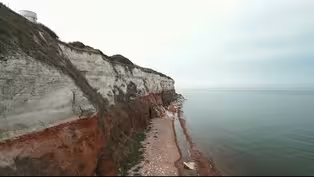
Ancient Earth Was a Hellscape
Clip: Season 50 Episode 11 | 3m 9sVideo has Closed Captions
For millions of years, Earth was a fiery hellscape, inhospitable to life.
For millions of years, ancient Earth was a fiery hellscape of volcanic activity, totally inhospitable to life. See what our planet might have looked like before the atmosphere—a ball of rock and fire hurtling through space.
Problems playing video? | Closed Captioning Feedback
Problems playing video? | Closed Captioning Feedback
National Corporate funding for NOVA is provided by Carlisle Companies and Viking Cruises. Major funding for NOVA is provided by the NOVA Science Trust, the Corporation for Public Broadcasting, and PBS viewers.

Ancient Earth Was a Hellscape
Clip: Season 50 Episode 11 | 3m 9sVideo has Closed Captions
For millions of years, ancient Earth was a fiery hellscape of volcanic activity, totally inhospitable to life. See what our planet might have looked like before the atmosphere—a ball of rock and fire hurtling through space.
Problems playing video? | Closed Captioning Feedback
How to Watch NOVA
NOVA is available to stream on pbs.org and the free PBS App, available on iPhone, Apple TV, Android TV, Android smartphones, Amazon Fire TV, Amazon Fire Tablet, Roku, Samsung Smart TV, and Vizio.
Buy Now

NOVA Labs
NOVA Labs is a free digital platform that engages teens and lifelong learners in games and interactives that foster authentic scientific exploration. Participants take part in real-world investigations by visualizing, analyzing, and playing with the same data that scientists use.Providing Support for PBS.org
Learn Moreabout PBS online sponsorship- [Narrator] Millions of years after the birth of the planet, there's still no atmosphere as we know it.
(ethereal music) (debris whooshes) But that is going to change.
(ominous music) - Four-and-a-half billion years ago, the Earth would've been a very violent place.
- Such that it's called the Hadean, which comes from the god Hades, the Greek god of the underworld 'cause it was imagined to be a hellish kind of place.
(eerie music) (ground explodes) (eerie music) - [Narrator] Across the globe, molten magma surges up from within.
(eerie music) (lava whooshing) Rivers of fire unleash a cocktail of gases.
(explosion booms) (eerie music) Carbon dioxide, nitrogen, and methane explode out of volcanoes in thick plumes.
(eerie music) These are the building blocks of our early atmosphere.
(eerie music) And we can see echoes of this young planet still on Earth today.
(light electronic music) - The volcanoes that we have here in Iceland look very similar to those that we had four-and-a-half billion years ago.
The early Earth was dominated by volcanic activity, and this lasted for millions of years.
(light electronic music) Those volcanoes acted as pathways for the gasses that attract inside the magma to escape into our atmosphere.
- [Narrator] But how do scientists know what the atmosphere was like in the past?
Surprisingly, clues are hidden in some of the rocks we find today.
- Throughout Earth's history and evolution, there's been a dynamic interplay between the Earth's surface and the Earth's atmosphere.
And because of this interplay, there are chemical fingerprints that are trapped in rocks.
(light electronic music) - The rock I'm holding in my hand is 3.4 billion years old.
And there are tiny bubbles trapped in this rock that are samples of Earth's ancient atmosphere.
So we can measure the gases and piece together evidence of what the atmosphere was like in the past.
(light electronic music)
Ancient Earth May Have Had Red Oceans
Video has Closed Captions
Clip: S50 Ep11 | 3m 34s | On Ancient Earth, rust deep in the oceans played a critical role in the formation of Earth (3m 34s)
Providing Support for PBS.org
Learn Moreabout PBS online sponsorship
- Science and Nature

Capturing the splendor of the natural world, from the African plains to the Antarctic ice.

- Science and Nature

Learn how centuries of knowledge helped our ancestors understand the mysteries of space.












Support for PBS provided by:
National Corporate funding for NOVA is provided by Carlisle Companies and Viking Cruises. Major funding for NOVA is provided by the NOVA Science Trust, the Corporation for Public Broadcasting, and PBS viewers.


